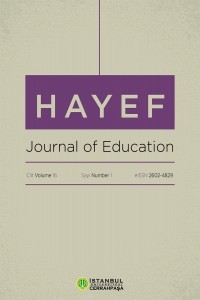FARKLI YAZMA ETKİNLİKLERİNİN 6. SINIF ÖĞRENCİLERİNİN DÜŞÜNCELERİ VE DAVRANIŞLARI ÜZERİNDEKİ ETKİLERİNİN BELİRLENMESİ
Matematik Öğretimi, Matematikte Yazma Etkinlikleri, Yazarak Öğrenme, Araştırmacı Öğretmen Yöntemi
___
- Etkilerinin Belirlenmesi
- Albert, L. R. (2000). Outsıde-in-inside-out: seventh-grade students' mathematical thought processes. Educational Studies in Mathematics, 4 1 , 1 0 9 - 1 4 1 .
- Allal, L & Ducrey, G. P. (2000). Assessment of—or in—the zone of proximal development. Learning and Instruction, 1 0 , 1 3 7 - 1 5 2 .
- Arends, R. I. (2004). Learning to teach (8th ed.). USA: McGraw-Hill.
- Baki, A. (1996). Okul matematiğinde ne öğretelim, nasıl öğretelim? Milli Eğitim Dergisi, 89, 7 2 - 7 6 .
- Baumann, A. S., Bloomfield, A. & Roughton, L. (1997). Becoming a secondary school teacher. Great Britain: Hodder and Stoughton.
- Bolte, L. A. (1999). Enhancing and assessing preservice teachers' integration and expression of mathematical knowledge. Journal of Mathematics Teacher Education, 2,167-185.
- Cohen, L. & Manion, L. (1998). Research methods in education (4th ed.). New York: Routledge Publication.
- Countryman, J. (1992). Mat forum learning and mathematics writing math. Conutryman. htm.http://mathforum.org.
- DeVries, R. (2000). Vygotsky, Piaget and education: A reciprocal assimilation of theories and educational practices. New Ideas in Psychology, 18, 187ı 213.
- DiCamilla, F.J. & Anton, M. (1997). Repetition in the collaborative discourse of İ2 learners: A Vygotskian perspective. The Canadian Modern Language Review, 53, 609-633.
- Dibartolo, M. T. (2000). Writing opportunities as a teaching/learning tool in a college mathematics course. Doktora tezi, Columbia University.
- Goss, M., Galbraith, P. & Renshaw, P. (2002). Socially mediated metacognition: Creating collaborative zones of proximal development in small group problem solving. Educational Studies in Mathematics, 4 9 , 1 9 3 - 2 2 3 .
- Harland, T. (2003). Vygotsky's zone of proximal development and problem- based learning: linking a theoretical concept with practice through action research. Teaching in Higher Education, 8, 2 6 3 - 2 7 2 .
- Hoel, T.L. (1997). Voices from the classroom. Teaching and Teacher Education, 13, 5 - 1 6 .
- Ercan Alasoy, $engiit Atasoy
- Howe, A. C. & Jones, L. (1998). Engaging children in science (2nd ed.). New Jersey: Printice-Hall, 175 s.
- Jurdak, M. & Zein, R.A. (1998). The effect of journal writing on achievement in and attiduates toward mathematics. School Science and Mathematics, 9 8 , 4 1 2 - 4 1 9 .
- Kallman, C. (1991). The effects of journal writing on the beliefs, attitudes and achievement of elementary education students in a content course in mathematics. Doktora Tezi, Department of Instructionai Leadership and Academic Curriculum, Oklahoma, The Universty of Oklahoma.
- Nationai Numeracy Strategy, (2003). Teaching the daily mathematics lesson to children with severe or profound and multiple learning difficulties.
- Pugaiee, D. K. (2004). Acomparision of verba and written descriptions of students' problem solving processes. Educational Studies in Mathematics, 55, 2 7 - 4 7 .
- Quinn.R. J . & Wilson, M. M. (1997). Writing in the mathematics classroom: Teachers and practies. Academic Search Premier, 7 1 , 1 .
- Schurter, W.A. (2002). Comprehension monitoring: An aid to mathematical problem solving. Journal of Developmental Education, 26, 2 2 - 3 3 .
- Smagorinsky, P. (1989). The reliability and validity of protocol analysis. Written Communication, 6, 463-479.
- Stonewater, J.K. (2002). The mathematics writer's checklist: The development of a preliminary assessment tool for writing in mathematics. School Science and Mathematics, 102, 324-334.
- Başlangıç: 2004
- Yayıncı: İstanbul Üniversitesi-Cerrahpaşa
İLKÖĞRETİM BİRİNCİ KADEME ÖĞRENCİLERİNİN SINIF-İÇİ OLUMSUZ DAVRANIŞLARININ DEĞERLENDİRİLMESİ
KLASİK EĞİTİME DESTEK OLARAK WEB ÜZERİNDEN ÖDEV HAZIRLAMA SÜRECİ ÖRNEĞİ
Zerrin AYVAZ REİS, Sevinç GÜLSEÇEN, Çiğdem SELÇUKCAN, Ceyda AKAYDIN, Okan BAŞOĞLU
OKUL YÖNETİCİLERİNİN GENEL ÖZELLİKLERİ VE YÖNETİCİLİK TUTUMLARIYLA İLGİLİ BİR ARAŞTIRMA
